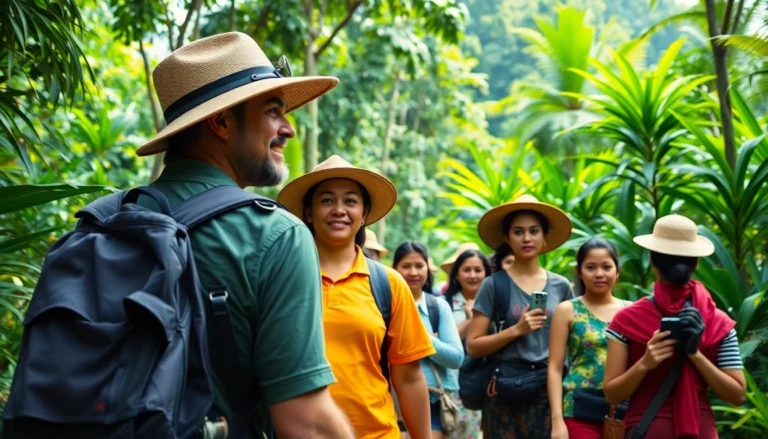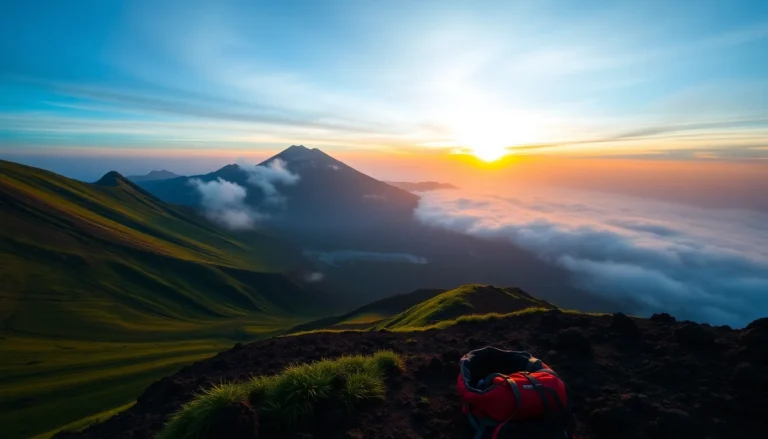
Introduction to Mt. Rinjani
Perched majestically on the island of Lombok, Indonesia, Mt. Rinjani stands as one of Southeast Asia’s most impressive volcanic landmarks. As the second highest volcano in Indonesia, reaching a commanding altitude of 3,726 meters (12,224 feet), it captivates adventurers, nature lovers, and cultural explorers alike. Its prominent presence not only defines the skyline of Lombok but also embodies a deep historical and cultural significance for local communities. Mount Rinjani’s active volcanic nature, coupled with its unique bio-diverse ecosystems, makes it a fascinating subject of study and exploration. From its origins to its current status within protected national park boundaries, understanding Mt. Rinjani is essential for appreciating Indonesia’s volcanic landscape and the adventure opportunities it offers.
Geographical Location and Significance
Location and Physical Features
Mount Rinjani is situated on the northern part of Lombok Island in West Nusa Tenggara, Indonesia. Geographically, it covers an area of approximately 41,330 hectares within the Rinjani National Park. The mountain is part of a complex volcanic system with a prominent caldera, known as the Segara Anak, which measures roughly 8 x 11 kilometers. The caldera houses a crater lake, known for its stunning turquoise waters, that has formed due to past massive eruptions. The region’s volcanic activity plays a crucial role in shaping local geological processes, influencing biodiversity, and supporting the island’s agricultural practices.
Geophysical and Geological Overview
As an active stratovolcano, Mt. Rinjani’s geological history spans thousands of years, with records of eruptions dating back at least several centuries. Its formation is attributed to the subduction of the Indo-Australian Plate beneath the Eurasian Plate, a geological process responsible for much of Indonesia’s volcanic activity. The volcano’s current height of 3,726 meters makes it a dominant feature in Lombok’s topography. Its eruptions have ranged from minor ash emissions to major explosive events, shaping the landscape and creating fertile volcanic soils that support lush forests and vibrant ecosystems.
Ecological Significance
The mountain’s surroundings are part of a protected biosphere reserved for diverse flora and fauna. The bio-diversity includes tropical rainforests, montane forests, and unique endemic species both plant and animal. The park’s ecological importance stems from its role in maintaining regional biodiversity corridors and providing habitat for endangered species such as the ebony tree, the Javan hawk-eagle, and the Rinjani leaf monkey. The ecological health of this environment is vital, not only for biodiversity conservation but also for the local communities dependent on its resources.
Historical and Cultural Importance
Historical Context of Rinjani
Mount Rinjani’s volcanic activity is woven into the historical tapestry of Lombok. Ancient legends and local folklore associate the mountain with spirits and deities, and archaeological discoveries suggest that humans have revered it for centuries. Evidence of early settlements near the slopes indicates that Rinjani has long been a sacred site for indigenous Sasak and Lombok communities, who performed rituals and offerings to appease the volcano’s spirits. Its eruptions have historically impacted local populations, leading to migrations and adaptations, but the mountain has retained its spiritual significance throughout the ages.
Cultural Significance and Local Traditions
In Lombok, Rinjani is more than a geographical feature; it embodies cultural identity. The mountain is central to traditional ceremonies such as the Sasak “Pawon” rituals, which seek blessings for fertility, agricultural success, and harmony. Local legends tell of the mountain’s role as a guardian and protector for the island, reinforcing its revered status. The cultural connection enhances the spiritual adventure for trekkers and pilgrims alike, fostering a deep respect for the mountain’s heritage and natural power.
Modern-day Cultural Practices
Contemporary practices include annual festivals and communal rituals observed at various temples and sites on the mountain’s slopes. These events attract visitors and worshippers, highlighting the enduring relationship between people and Rinjani. Respect for the mountain’s sanctity is integral when planning excursions, with local guides often incorporating cultural narratives into trekking experiences to deepen visitors’ understanding and appreciation.
Key Features of Mt. Rinjani
Volcanic Features
The core features of Rinjani include its active volcano cone, the caldera, and the crater lake Segara Anak. The volcano’s summit features a classic stratovolcano shape, with a crater measuring approximately 700 meters in diameter. The active volcano periodically releases ash plumes and occasionally erupts, with the latest notable eruption in December 2015, which temporarily affected air travel and nearby settlements. The caldera’s aquamarine lake is a popular trekking destination, renowned for its serenity and natural beauty.
Biological Diversity
Controlled within the bounds of the national park, Rinjani’s ecological zones range from mangroves at sea level to montane forests near the summit. The park’s flora includes species such as the Rinjani ebony, various orchids, and endemic hardwoods. Fauna comprises species like the Rinjani leaf monkey, hornbills, and numerous butterfly species, making it an ecological hotspot. The diversity underscores the ecological resilience of the volcanic landscape.
Water Resources and Ecosystem Services
The mountain’s lakes, rivers, and springs are vital water sources for Lombok’s communities. The Segara Anak lake, for example, supplies fresh water and sustains local fisheries. The ecosystem services provided by Rinjani support agriculture, livelihoods, and tourism, illustrating the interconnectedness between natural features and human well-being.
Planning Your Rinjani Trek
Preparing Equipment and Supplies
Successfully undertaking a trek to Mt. Rinjani requires meticulous preparation. Essential gear includes sturdy hiking boots, layered clothing suitable for fluctuating temperatures, a warm jacket for higher altitudes, rain gear, headlamp, trekking pole, and sufficient water and nutrition supplies. Consider bringing a portable stove, sleeping bag, and tent if opting for a self-guided or more rustic experience. Due to the mountain’s challenging terrain and unpredictable weather, investing in quality equipment is paramount for safety and comfort.
Best Times to Visit and Weather Conditions
The ideal trekking season spans from May to September, coinciding with the dry season and clearer skies. During this period, weather conditions are more predictable and conducive to safe hiking. The wet season (November to April) brings increased rainfall, muddy trails, and the risk of landslides and volcanic activity, which can disrupt plans. Monitoring weather forecasts and volcanic activity updates from authorities such as the Indonesian Volcanological Center is recommended before embarking on your journey.
Required Permits and Official Procedures
Travelers must secure permits to trek within the Rinjani National Park. These are obtained through official channels such as local tour operators or park offices. The permit process often includes registration, payment of entrance fees, and, if applicable, guided trek arrangements. It is advisable to engage licensed guides to ensure safety, adhere to regulations, and support sustainable tourism practices. Visitors should also familiarize themselves with park regulations concerning environmental conservation and safety protocols.
Trail Routes and Difficulty Levels
Sembalun vs. Senaru Routes
The two primary routes to Rinjani’s summit are Sembalun and Senaru, each offering unique trekking experiences. The Sembalun route, starting from the east, is relatively gentle with well-maintained paths and panoramic views, making it popular among hikers with moderate fitness levels. Conversely, the Senaru route, originating from the north, is more challenging, featuring steeper sections and dense forests, suitable for experienced climbers seeking adventure. Both routes lead to the summit crater, with sufficient orientation and planning.
Estimated Trekking Duration and Challenges
Typically, the trek takes approximately 3 to 4 days, depending on fitness levels and chosen route. The ascent to the summit from the base camps requires navigating rugged terrains, high-altitude acclimatization, and managing fatigue. Common challenges include altitude sickness, unpredictable weather, fatigue, and navigating steep, uneven trails. Adequate preparation and guidance can mitigate these challenges, ensuring a rewarding summit experience.
Guided vs. Independent Climbing Options
Opting for guided tours significantly enhances safety, logistics, and cultural insights. Licensed guides provide navigational assistance, carry permits, and handle emergency support. Self-guided climbs are possible but demand extensive preparation, familiarity with mountain logistics, and experience in wilderness trekking. The decision should be made based on skill level, travel objectives, and comfort with remote high-altitude environments. Notably, guided tours often include equipment, porters, and logistical support, easing the physical and mental load on climbers.
Safety, Risks, and Eruption History
Volcanic Activity Monitoring and Alerts
Mt. Rinjani’s status as an active volcano necessitates vigilant monitoring by Indonesian authorities, including the Center for Volcanology and Geological Disaster Mitigation. Real-time updates and eruption alerts are disseminated through official channels and local guides. Tourists are advised to stay informed about current activity levels, as volcanic eruptions can occur with little warning, impacting accessibility and safety. Emergency protocols are in place, and climbers should heed all warnings and restrictions.
Common Hazards and How to Avoid Them
Potential hazards include ash clouds, lava flows, landslides, and altitude sickness. During eruptions, ash inhalation can cause respiratory issues; therefore, masks and eyewear are recommended. Landslides and unstable terrain are risks during heavy rainfall. To minimize dangers, hikers should avoid unstable slopes, stay on designated trails, and avoid ascending during volcanic alerts. Proper acclimatization, hydration, and rest are critical to prevent altitude sickness, especially at higher elevations near the summit.
Emergency Response and Support Services
In case of emergencies, trekkers can rely on park rangers, local guides, and rescue teams, who are equipped to handle high-altitude incidents and volcanic events. Emergency communication devices, such as satellite phones or emergency beacons, are advised for remote parts of the trail. It is crucial to have comprehensive travel insurance covering mountain rescue and medical evacuation. Pre-arranged support from reputable tour operators can also facilitate swift response times during unforeseen events.
Experiencing Mt. Rinjani: Highlights and Tips
Best Photographic Spots on the Mountain
Photographers will find a wealth of breathtaking vistas at key points like the Summit Viewpoint, Teletubbies Hill, the rim of Segara Anak Lake, and sunrise views from the crater’s edge. Early mornings and late afternoons offer the best lighting conditions. Capture the volcanic landscape, lush forests, and traditional Sembalun and Senaru villages to create memorable visuals that showcase Lombok’s natural beauty. Use wide-angle lenses for expansive scenery and adapt exposure settings to highlight dramatic sky and volcanic features.
Local Culture and Nearby Attractions
Beyond the mountain itself, visitors can immerse in Lombok’s diverse culture and attractions. Explore traditional Sasak villages, learn about weaving crafts, and participate in local ceremonies. Nearby cultural sites include the old Muslim mosques, ancient Hindu temples, and customary markets. For a post-trek respite, consider visiting nearby waterfalls like Sendang Gila or Tiu Teja, or relaxing on the pristine beaches of Senggigi and Gili Islands.
Post-Trek Accommodation and Local Cuisine
After conquering Rinjani, abundant accommodation options await in Lombok, from eco-lodges and guesthouses to luxury resorts. Many trekkers choose to stay in Sembalun Valley or Senaru, where local homestays offer authentic Lombok hospitality. The local cuisine, rich in spices and flavors, includes dishes like Ayam Taliwang, Plecing Kangkung, and fresh seafood. Sampling traditional foods provides a culinary connection to Lombok’s vibrant culture and enhances the overall adventure experience.



